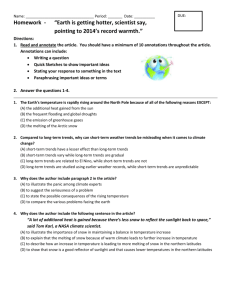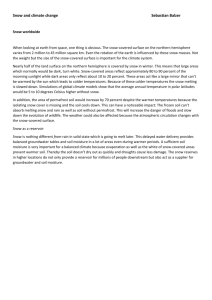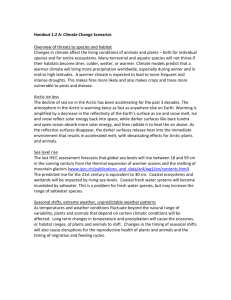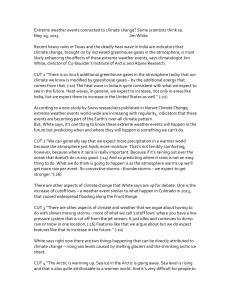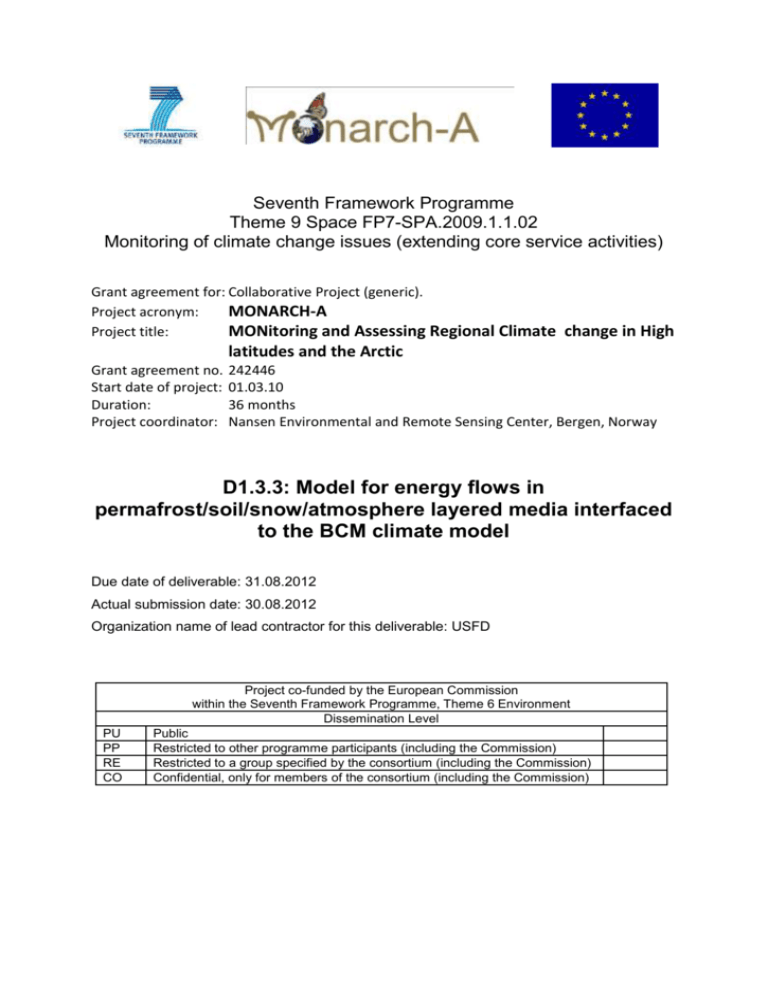
Seventh Framework Programme
Theme 9 Space FP7-SPA.2009.1.1.02
Monitoring of climate change issues (extending core service activities)
Grant agreement for: Collaborative Project (generic).
Project acronym:
MONARCH-A
Project title:
MONitoring and Assessing Regional Climate change in High
latitudes and the Arctic
Grant agreement no.
Start date of project:
Duration:
Project coordinator:
242446
01.03.10
36 months
Nansen Environmental and Remote Sensing Center, Bergen, Norway
D1.3.3: Model for energy flows in
permafrost/soil/snow/atmosphere layered media interfaced
to the BCM climate model
Due date of deliverable: 31.08.2012
Actual submission date: 30.08.2012
Organization name of lead contractor for this deliverable: USFD
Project co-funded by the European Commission
within the Seventh Framework Programme, Theme 6 Environment
Dissemination Level
PU
PP
RE
CO
Public
Restricted to other programme participants (including the Commission)
Restricted to a group specified by the consortium (including the Commission)
Confidential, only for members of the consortium (including the Commission)
MONARCH-A
MONitoring and Assessing Regional Climate change in
High latitudes and the Arctic
Grant agreement n° 242446
ISSUE
DATE
CHANGE RECORDS
Ref: D.1.3.3
Date:31/08/2012
Issue: 0.1
AUTHOR
0
Document1
Page: 2/21
MONARCH-A
MONitoring and Assessing Regional Climate change in
High latitudes and the Arctic
Grant agreement n° 242446
Ref: D.1.3.3
Date:31/08/2012
Issue: 0.1
SUMMARY
Attempts by land surface models to capture the current state of boreal latitudes and give short-term
predictions are hindered by two factors: i) the lack of ground-reference data and ii) the complexity
and feedbacks of the physical processes involved. We examined a set of the most prominent land
surface models in order to establish which ones incorporate a set of processes we deem essential to
describe energy flows in an Arctic environment. It was found that none of the models incorporated all
of the necessary processes and we concluded that the most attractive approach to acquire a land
surface model fit for simulation of Arctic carbon fluxes was to improve the LPJ-WM model. Even
though we added a more realistic fire disturbance and snow density algorithm we concluded that
further improvements of the boundary conditions are necessary; we then proceed to point at feasable
approaches with which these improvements can be achieved.
Document1
Page: 3/21
MONARCH-A
MONitoring and Assessing Regional Climate change in
High latitudes and the Arctic
Grant agreement n° 242446
Ref: D.1.3.3
Date:31/08/2012
Issue: 0.1
MONARCH-A CONSORTIUM
Participant no.
Participant organisation name
Short name
Country
1 (Coordinator)
Nansen Environmental and Remote Sensing Center
NERSC
NO
2
The University of Sheffield
USFD
UK
3
Universität Hamburg
UHAM
NO
4
Centre National de la Recherche Scientifique
CNRS
FR
Scientific foundation Nansen International
NIERSC
5
Environmental and Remote Sensing Center
RU
6
Universitetet i Bergen
UiB
NO
7
Danmarks Tekniske Universitet
DTU
DK
Institut Francais de Recherche pour l'Exploitation de la
IFREMER
8
Mer
FR
No part of this work may be reproduced or used in any form or by any means (graphic, electronic, or
mechanical including photocopying, recording, taping, or information storage and retrieval systems)
without the written permission of the copyright owner(s) in accordance with the terms of the
MONARCH-A Consortium Agreement (EC Grant Agreement 242446).
All rights reserved.
This document may change without notice.
Document1
Page: 4/21
MONARCH-A
MONitoring and Assessing Regional Climate change in
High latitudes and the Arctic
Grant agreement n° 242446
Ref: D.1.3.3
Date:31/08/2012
Issue: 0.1
Table of Contents
Table of Contents .................................................................................................................................... 5
1
Introduction ..................................................................................................................................... 8
2
Methodology ................................................................................................................................. 10
2.1
Essential Processes ................................................................................................................ 10
2.2
Model for energy flows in the Arctic ..................................................................................... 14
3
Conclusions.................................................................................................................................... 19
4
References ..................................................................................................................................... 21
Document1
Page: 5/21
MONARCH-A
MONitoring and Assessing Regional Climate change in
High latitudes and the Arctic
Grant agreement n° 242446
Ref: D.1.3.3
Date:31/08/2012
Issue: 0.1
List of Figures
Figure 1: (top) Temporal correlation coefficient between SWE estimated by JULES and ground
measurements for 1981-2006 over the former Soviet Union. (bottom) As above but for grid-cells
with correlation coefficients greater than 0.7. ............................................................................. 14
Figure 2: CDF of fractional annual burnt area per disturbed grid cell for GFED-BA and LPJ-WMa. On
average, GFED-BA indicates about 8% of grid cells to be disturbed each year. Values with
percentage burnt area exceeding 40% have probability less than 0.0012 so are omitted from the
CDF plot. ........................................................................................................................................ 16
Figure 3: (top) Monthly soil temperatures for altered and original boundary conditions (B.C.) at depth
of 0.1 m produced by LPJ-WMa at a site which experienced more than 99% of burn; the arrow
marks the year of the fire disturbance. (bottom) Thaw depth averaged over summer months for
the same sites. ............................................................................................................................... 18
Document1
Page: 6/21
MONARCH-A
MONitoring and Assessing Regional Climate change in
High latitudes and the Arctic
Grant agreement n° 242446
Ref: D.1.3.3
Date:31/08/2012
Issue: 0.1
List of Tables
Table 1: Essential processes for land surfaces models to describe an Arctic environment; green and
red indicate their presence or absence, respectively, in the 4 land surface models considered. 13
Document1
Page: 7/21
MONARCH-A
MONitoring and Assessing Regional Climate change in
High latitudes and the Arctic
Grant agreement n° 242446
Ref: D.1.3.3
Date:31/08/2012
Issue: 0.1
1 Introduction
Temperature response to climate scenarios show considerable warming of the northern
latitudes in the 21st century [Serreze and Francis, 2006] with projected increase of 0.25-0.75 °C per
decade over the next 100 years [Christensen et al., 2007]. The significance of these regions lies in the
fact that they hold 1/3 of the global terrestrial carbon [McGuire et al., 1995] and 1/2 of the global
below-ground carbon [Tarnocai et al., 2009] most of which is located in areas of continuous and
discontinuous permafrost. Discontinuous permafrost areas are considered the most sensitive to
climate change as they are close to thawing, with soil temperatures reaching -1°C [Yoshikawa et al.,
2002]. Low temperatures in the boreal latitudes have kept carbon decomposition rates low over the
past millennia, leading to carbon accumulation, but an increase of soil temperature and subsequent
permafrost thawing might reverse this effect by accelerating soil carbon decomposition, with
increased emissions of greenhouses gases (CO2 and CH4) to the atmosphere .
Attempts by land surface models to capture the current state of boreal latitudes and give shortterm predictions are hindered by two factors: i) the lack of ground-reference data and ii) the
complexity and feedbacks of the physical processes involved. The lack of ground-reference data is
merely a consequence of the low population density of these regions and, although the past 40 years
of satellite data have alleviated part of the problem, remote sensing data are often accompanied by
both substantial uncertainty due to lack of reference data and also problems in the retrieval of
variables that are inherently difficult to measure.
The added complexity in describing the physical processes in boreal latitudes originates from the
presence of the snow pack, organic soil (peats and bogs), and permafrost. Energy fluxes must be
simulated explicitly for each layer of the model grid-cell, with boundary conditions and thermal
properties also defined. To define boundary conditions on the soil/snow surface, canopy radiative
transfer models are required, while an accurate representation of the thermal properties of the
Document1
Page: 8/21
MONARCH-A
MONitoring and Assessing Regional Climate change in
High latitudes and the Arctic
Grant agreement n° 242446
Ref: D.1.3.3
Date:31/08/2012
Issue: 0.1
layers needs detailed knowledge of their characteristics, such as snow water equivalent (SWE) and
snow density for the snow layer, organic and mineral content for the soil, water content for the
permafrost layer, etc. Furthermore, feedbacks amongst these layers are significant. Snow, for
instance, acts as an insulator, so the projected increase of precipitation [Christensen et al., 2007] can
affect soil heat fluxes and the distribution of the permafrost layer. Another example is the projected
temperature increase, which if it leads to more frequent and severe fire events with the removal of
the insulating organic soil and increase of albedo, could lead to permafrost thawing.
Document1
Page: 9/21
MONARCH-A
MONitoring and Assessing Regional Climate change in
High latitudes and the Arctic
Grant agreement n° 242446
Ref: D.1.3.3
Date:31/08/2012
Issue: 0.1
2 Methodology
Having considered the specific challenges of modeling land processes in boreal latitudes we
examined a set of the most prominent land surface models in order to establish which ones
incorporate a set of processes we deem essential to describe energy flows in an Arctic environment.
The models examined were the Community Land Model (CLM4CN) [Oleson, 2010], the Joint UK Land
Environment Simulator (JULES) [Best et al., 2011], the Lund-Potsdam-Jena Wetland Hydrology (LPJWM) [Wania et al., 2009] and the Sheffield Dynamic Global Vegetation Model (SDGVM) [Woodward
et al., 1995].The list of the essential processes is given below, together with a brief description of
their importance in the Arctic. We also documented how each land surface model mentioned above
deals with these processes, with synoptic results presented in Table 1.
2.1 Essential Processes
Variation in Snow Density
The importance of snow density in the energy balance lies in the fact that it determines the
thermal properties of the snow pack, with thermal conductivity proportional to snow density [Sturm,
1992], while it also affects radiation balance because of its effect on albedo [Armstrong and Brun,
2008]. Snow density is related to snow depth and SWE by:
SWE = depth x mean density
Snow density varies according to a plethora of environmental factors, and its evolution begins
from the moment it is created in the atmosphere. It is thus customary for studies of snow density to
break down the evolution into changes up to the moment of its deposition, which define the fresh
snow density, and later ones, up to melting.
Historically, fresh snow density is considered to follow the 10-1 rule for the water to snow density
ratio, i.e. fresh snow has a density of 100 kg/m3, although factors such as atmospheric temperature
Document1
Page: 10/21
MONARCH-A
MONitoring and Assessing Regional Climate change in
High latitudes and the Arctic
Grant agreement n° 242446
Ref: D.1.3.3
Date:31/08/2012
Issue: 0.1
can cause significant variations [Judson and Doesken, 2000; Roebber et al., 2003]. In fact, this rule is
only followed by one of the models considered, SDGVM; both JULES and LPJ-WM adopt a constant
fresh snow density of 150kg/m3, while CLM4CN defines fresh snow density as a function of air
temperature.
After deposition the snow pack continually evolves and its density changes due to factors that
include prevailing weather conditions, time and overburden pressure. These are important processes
that affect thermal characteristics and albedo of the snowpack but are only embedded in CLM4CN
and JULES and are absent from SDGVM and LPJ-WM.
Stratified Snowpack
Since snowfall occurs as discrete events, the snowpack becomes stratified, with each layer having a
different density and thus different thermal properties. Both CLM4CN and JULES incorporate such a
snowpack where energy fluxes are calculated for each layer using a discrete approach to evaluate
heat diffusion. Even though model outputs of the snowpack characteristics involve weighted
averages of the different layers, a stratified snowpack is essential to accurately capture its insulating
effect.
Endemic Plant Functional Types: In the Arctic, low average annual air temperatures and high soil
water content, in part arising from perched water tables due to permafrost, have caused the rate of
carbon deposition to be on average higher than decomposition through the Holocene era, leading to
net accumulation of carbon. This carbon originates from a variety of plant types, such as C4 grass, but
also endemic PFTs such as sphagnum whose decomposition creates the characteristic peat bogs.
These accumulations of organic carbon act as a thermal insulator to the underlying permafrost and it
is feared that the projected increase of Arctic temperature will lead to increased decomposition rates
and reduction of the surface carbon, with resulting loss of its insulating capacity. It is therefore
Document1
Page: 11/21
MONARCH-A
MONitoring and Assessing Regional Climate change in
High latitudes and the Arctic
Grant agreement n° 242446
Ref: D.1.3.3
Date:31/08/2012
Issue: 0.1
important for land surface models to correctly describe the characteristics and dynamics of plant
types that are endemic to the Arctic. Out of the 4 models only LPJ-WM incorporates plant functional
types representative of Arctic grass, while the other models instead use generic grass types.
Organic Soils: Due to their large carbon content, certain soils in the Arctic are differentiated from
typical mineral soils and are taxonomically labeled as organic. Organic soils can hold more water and
have different percolation rates than mineral soils. Only the CLM4CN and LPJ-WM models
incorporate organic soils.
Stratified soil energy fluxes: Even though the characteristics of soil can be considered constant over
the relatively shallow depths considered in land models, water content is not, and all models define it
explicitly for a number of layers. For a model to encapsulate permafrost dynamics, it must describe
heat exchange between soil layers with different water content, since the high heat capacity of water
means that it acts as a buffer. Accurate description of these processes allows land surface models to
evaluate permafrost presence, as they calculate soil temperature at specific depths. CLM4CN, JULES
and LPJ-WM all contain the necessary subroutines to describe heat fluxes in stratified soils containing
water or ice.
Surface Energy Fluxes: In CLM4CN and JULES the boundary conditions for the calculation of the soil
or snow heat flux are provided by canopy radiative transfer sub-models which involve incoming solar
radiation, surface albedo and thermal properties of the canopy. LPJ-WM instead uses as its upper
boundary condition the air temperature provided by the climate driver; this is less desirable because
it is not affected by dynamic changes in the canopy.
Table 1 below gives an overview of which of the essential processes listed above exist in each of the
models considered.
Document1
Page: 12/21
MONARCH-A
MONitoring and Assessing Regional Climate change in
High latitudes and the Arctic
Grant agreement n° 242446
Ref: D.1.3.3
Date:31/08/2012
Issue: 0.1
Realistic Fire Disturbance: The previous sub-sections have indicated the model requirements to
correctly model energy flows at individual grid-cells in an Arctic environment. However, the
deliverable D1.4.1: “Analysis of available land cover and fire products and recommendations for use
in climate models” showed that fire can play an important role in permafrost dynamics by making
large changes in the land cover and soil, and hence disrupting the energy flows through the
atmosphere-snow-vegetation-soil system. D1.4.1 contains an extensive study of how fire processes
are represented in land surface models using earth observational data as reference; it reveals that
none of the models capture the statistical characteristics of the fire regime in boreal latitudes. Fire
disturbance constitutes a key process not only because it removes carbon stored in vegetation,
surface litter and the soil and transfers it to the atmosphere, but in doing so it produces three effects
that bear on permafrost, by affecting the soil heat flux and thermal balance:
(i) removal of insulating layers that affect heat diffusion;
(ii) removal of vegetation layers, allowing radiation to impinge directly on the soil;
(iii) decrease in surface albedo, leading to increased absorption of radiation by the soil.
CLM4CN
JULES
SDGVM
LPJ-WM
Variable Snow
Density
Stratified
Snowpack
Endemic Plant
Functional
Types
Organic Soils
Stratified Soil
Energy Fluxes
Surface Energy
Fluxes
Realistic Fire
Disturbance
Table 1: Essential processes for land surfaces models to describe an Arctic environment; green and red indicate
their presence or absence, respectively, in the 4 land surface models considered.
Document1
Page: 13/21
MONARCH-A
MONitoring and Assessing Regional Climate change in
High latitudes and the Arctic
Grant agreement n° 242446
Ref: D.1.3.3
Date:31/08/2012
Issue: 0.1
2.2 Model for energy flows in the Arctic
As seen from Table 1, none of the four models examined incorporated all seven of the processes
we consider necessary for reliable modeling of the land surface in an Arctic environment. Also,
having a process in a model does not guarantee that it is accurately represented. For example, we
used time series of ground reference transect data [Krenke, 2004] to assess the accuracy of SWE in
JULES, a model which includes all necessary processes to simulate snow evolution, such as variable
snow density and a multi-layered snow pack. Results showed that despite quite good reproduction of
the temporal behaviour of SWE, as indicated by temporal correlation (Fig. 1(top)), JULES severely
underestimates its magnitude(Fig.1(bottom)).
Figure 1: (top) Temporal correlation coefficient between SWE estimated by JULES and ground measurements for
1981-2006 over the former Soviet Union. (bottom) As above but for grid-cells with correlation coefficients
greater than 0.7.
Document1
Page: 14/21
MONARCH-A
MONitoring and Assessing Regional Climate change in
High latitudes and the Arctic
Grant agreement n° 242446
Ref: D.1.3.3
Date:31/08/2012
Issue: 0.1
Producing a model for energy flows in permafrost/soil/snow/atmosphere layered media can be
done in isolation, but in the context of MONARCH-A the key issue is to produce a model that fits
within the structure of a land surface model which itself is embedded in a climate model. From Table
1, it would seem that the most sensible approach to formulating a model that includes all necessary
processes for the boreal latitudes would be to add the endemic plant functional types and organic
soil to CLM4CN or JULES. In reality, the vegetation sub-models where the PFT types are defined are
the core of any land surface model, and altering them would require a complete model overhaul and
re-parameterization. Instead, altering LPJ-WM, which contains specific Arctic PFTs, e.g. by allowing
the snow density to vary instead of remaining constant, as in the current implementation, would
improve the simulation of permafrost dynamics without requiring extensive modifications as our
preliminary implementation showed. Similarly, even though adding surface energy fluxes in LPJ-WM
involves a certain degree of complexity, it merely alters the boundary conditions of the existing
energy balance; the main part of the model can remain as is. Hence we focused our attention on
improving LPJ-WM; note that LPJ forms the land surface model within the Bergen Climate Model.
As a first step towards formulating a land surface model which encompasses the necessary
processes to simulate energy flows at boreal latitudes, we modified the fire disturbance in LPJ-WM to
follow the statistical characteristics of reference data and specifically the Global Fire Emissions
Database-Burned Area product (GFED-BA) [van der Werf et al., 2010], a data set containing monthly
burned area on a global scale with a 0.5° resolution. Details are not presented in this document as an
extensive description of the methodology can be found in the Deliverable D1.4.3: ‘Integrated Fire
Products for Carbon and Climate Modeling’. Briefly stated, the LPJ-WM fire process was altered to
give burnt area statistical properties that more closely resemble the GFED-BA data, but without
changing the mean area burnt by the model. This was achieved by deriving the cumulative
distribution function (CDF) of the annual fraction burnt per disturbed grid cell from GFED-BA, and
forcing LPJ-WM to obey the same distribution; this modified version of LPJ-WM will be denoted as
Document1
Page: 15/21
MONARCH-A
MONitoring and Assessing Regional Climate change in
High latitudes and the Arctic
Grant agreement n° 242446
Ref: D.1.3.3
Date:31/08/2012
Issue: 0.1
LPJ-WMa. At the 0.5° resolution of GFED-BA, the CDF of annual fraction burnt area per disturbed grid
cell for boreal latitudes over the period 1997-2009 was found to be well approximated by a gamma
distribution of form:
p X x
x
1
t a 1 e t / b dt
a
0
b ( a )
with parameters a = 0.21 and b = 0.1 and expected value of 0.021. Fig.2 shows the observed CDF
and that produced by LPJ-WMa over the same period and spatial subset. Note that the CDF will
normally depend on the resolution of the dataset used to produce it.
Figure 2: CDF of fractional annual burnt area per disturbed grid cell for GFED-BA and LPJ-WMa. On average,
GFED-BA indicates about 8% of grid cells to be disturbed each year. Values with percentage burnt area
exceeding 40% have probability less than 0.0012 so are omitted from the CDF plot.
This methodology offers a more realistic fire regime for the model, but LPJ-WM still lacks a
radiative transfer model to describe the input radiation flux at the top of the snow/soil interface; this
provides necessary boundary conditions for the atmosphere-soil heat exchange. This omission is
crucial because, as stated in Deliverable D1.4.3, a further effect is that removal of canopy by fire
alters the radiation budget: for example, prior to disturbance, 30-65% of incoming solar radiation
reaches the forest floor in black spruce forests [Slaughter, 1983], while after a fire it exceeds 90%
[Kasischke et al., 1995]. This effect cannot be simulated by the current version of LPJ-WM, which
Document1
Page: 16/21
MONARCH-A
MONitoring and Assessing Regional Climate change in
High latitudes and the Arctic
Grant agreement n° 242446
Ref: D.1.3.3
Date:31/08/2012
Issue: 0.1
lacks a full radiation balance in the energy calculations. Hence an approximation was made in which
the input air temperature, which acts as an upper boundary condition for the heat diffusion equation,
was increased in the year after a fire and decreased as an exponential function of tree cover. This
simulates an increase of Leaf Area Index and associated attenuation of radiation according to BeerLambert’s Law.
The cumulative effect of these two modifications is illustrated by Fig.3 , in which the upper plot
shows the monthly soil temperatures at depth of 10 cm calculated by LPJ-WMa at a location
dominated by deciduous needle-leaved forest in northern Siberia after a fire with 99% fraction of
burn. Following the disturbance, the model initially sets herbaceous cover as the dominant PFT in the
grid-cell, while the needle-leaved PFT becomes dominant after 15 years. Fig. 3 shows that the
removal of litter and its subsequent damping effect increases the monthly variability of soil
temperature as it becomes more susceptible to air temperature and its periodic fluctuations. Since
summer soil temperatures now exceed 0° C, summer thaw depth increases by over 1.0 m and
requires more than 60 years to return to its pre-disturbed value; this is more consistent with field
data than when the boundary conditions were unchanged, in which case the increase in maximum
thaw depth due to loss of litter is less than 0.5 m, although the time to recovery of the original
temperature conditions is the same (see Fig.3).
Document1
Page: 17/21
MONARCH-A
MONitoring and Assessing Regional Climate change in
High latitudes and the Arctic
Grant agreement n° 242446
Ref: D.1.3.3
Date:31/08/2012
Issue: 0.1
Figure 3: (top) Monthly soil temperatures for altered and original boundary conditions (B.C.) at depth of 0.1 m
produced by LPJ-WMa at a site which experienced more than 99% of burn; the arrow marks the year of the fire
disturbance. (bottom) Thaw depth averaged over summer months for the same sites.
Document1
Page: 18/21
MONARCH-A
MONitoring and Assessing Regional Climate change in
High latitudes and the Arctic
Grant agreement n° 242446
Ref: D.1.3.3
Date:31/08/2012
Issue: 0.1
3 Conclusions
The most attractive approach to formulating a permafrost model compatible with the Bergen
Climate Model (BCM) was to improve the LPJ-WM model; LPJ is the land surface model embedded in
BCM. Better representation of permafrost and its dynamics is not just a case of producing a better
energy balance, but of correctly simulating the whole suite of processes that bear on it, including fire,
snow, soil and vegation processes. The limitations of the original form of LPJ-WM for permafrost
modelling are (see Table 1):
1. Lack of variable snow density or a stratified snow pack
2. Inadequate representation of surface energy fluxes
3. Unrealistic representation of fire disturbance
The modifications to LPJ-WM described above have addressed point (3) and provide more
realistic simulations of permafrost dynamics following a fire. Nonetheless, the modified model
formulation does not yet capture the full extent of fire-permafrost interactions, e.g., thaw depth
increases for several years after a fire, not only in the immediately following year, as in Fig. 3
[MacKay, 1970; Yoshikawa et al., 2002]. However, this could be achieved if fire were treated as a
continual process, rather than its effects being calculated in a single annual step as at present. The
result of this single annual step is that the concequences of fire disturbance start to take effect on
January 1st of each year which creates an unrealistic discontinuity in variable values. The most
difficult shortcoming to address is the inadequate representation of the radiation balance (point 2).
While the ad hoc approach used above illustrates the importance of this process, it is clearly only a
stopgap. An approach of simply transfering the ratiative transfer subroutines from the models that
encompass them (JULES and CLM4CN) into LPJ-WM is both sensible and feasible. The reasoning is
that the current version of LPJ-WM is only missing proper soil/snow boundary conditions since it
overimplifies by using the driving air temperature data set. Visualizing model processes as a column
Document1
Page: 19/21
MONARCH-A
MONitoring and Assessing Regional Climate change in
High latitudes and the Arctic
Grant agreement n° 242446
Ref: D.1.3.3
Date:31/08/2012
Issue: 0.1
of stratified layers, implementing the radiative transfer model of JULES would simply add a process
on the top of the column thus minimizing conflicts and interaction with other processes and reducing
complexity . A re-parameterization of the model would certainly be needed but the said method
would be the most cost-effective approach to acquire a land surface model that would include all the
essential processes needed to describe and accuretely simulate the carbon balance in the Arctic.
Document1
Page: 20/21
MONARCH-A
MONitoring and Assessing Regional Climate change in
High latitudes and the Arctic
Grant agreement n° 242446
Ref: D.1.3.3
Date:31/08/2012
Issue: 0.1
4 References
Armstrong, R. L., and E. Brun (Eds.) (2008), Snow & Climate:Physical Processes, Surface Energy
Exchange and Modeling, Cambridge University Press, Cambridge.
Best, M. J., et al. (2011), The Joint UK Land Environment Simulator (JULES), model description - Part 1:
Energy and water fluxes, Geosci Model Dev, 4(3), 677-699, doi: DOI 10.5194/gmd-4-677-2011.
Christensen, J. H., B. Hewitson, A. Busuioc, A. Chen, X. Gao, I. Held, R. Jones, and R. K. Kolli (2007),
Regional Climate Projections, in Climate Change 2007: The Physical Science Basis. Contribution of
Working Group I to the Fourth Assessment Report of the Intergovernmental Panel on Climate Change
edited by S. Solomon, D. Qin, M. Manning, Z. Chen, M. Marquis, K. B. Averyt, M. Tignor and H. L.
Miller, pp. 847-940, Cambridge University Press, Cambridge, U.K.
Judson, A., and N. Doesken (2000), Density of freshly fallen snow in the Central Rocky Mountains, B
Am Meteorol Soc, 81(7), 1577-1587.
Kasischke, E. S., N. L. Christensen, and B. J. Stocks (1995), Fire, Global Warming, and the Carbon
Balance of Boreal Forests, Ecol Appl, 5(2), 437-451.
Krenke, A. (2004), Former Soviet Union hydrological snow surveys, edited, NSIDC, Boulder,CO.
MacKay, J. R. (1970), Disturbances to the tundra and forest tundra environments of the western
Arctic, Canadian Geotechnical Journal, 7(4), 420-432.
McGuire, A. D., J. M. Melillo, D. W. Kicklighter, and L. A. Joyce (1995), Equilibrium responses of soil
carbon to climate change: Empirical and process-based estimates, J Biogeogr, 22(4-5), 785-796.
Oleson, K. W. (2010), Technical Description of version 4.0 of the Community Land Model, NCAR
Technical Note 47, 257.
Roebber, P. J., S. L. Bruening, D. M. Schultz, and J. V. Cortinas (2003), Improving snowfall forecasting
by diagnosing snow density, Weather Forecast, 18(2), 264-287.
Serreze, M. C., and J. A. Francis (2006), The arctic amplification debate, Climatic Change, 76(3-4),
241-264, doi: 10.1007/s10584-005-9017-y.
Slaughter, C. W. (1983), Summer Shortwave Radiation at a Subarctic Forest Site, Can J Forest Res,
13(5), 740-746.
Sturm, M. (1992), Snow Distribution and Heat-Flow in the Taiga, Arctic Alpine Res, 24(2), 145-152.
Tarnocai, C., J. G. Canadell, E. A. G. Schuur, P. Kuhry, G. Mazhitova, and S. Zimov (2009), Soil organic
carbon pools in the northern circumpolar permafrost region, Global Biogeochem Cy, 23, doi:
10.1029/2008gb003327.
van der Werf, G. R., J. T. Randerson, L. Giglio, G. J. Collatz, M. Mu, P. S. Kasibhatla, D. C. Morton, R. S.
DeFries, Y. Jin, and T. T. van Leeuwen (2010), Global fire emissions and the contribution of
deforestation, savanna, forest, agricultural, and peat fires (1997-2009), Atmos Chem Phys, 10(23),
11707-11735, doi: 10.5194/acp-10-11707-2010.
Wania, R., I. Ross, and I. C. Prentice (2009), Integrating peatlands and permafrost into a dynamic
global vegetation model: 1. Evaluation and sensitivity of physical land surface processes, Global
Biogeochem Cy, 23, doi: 10.1029/2008gb003412.
Woodward, F. I., T. M. Smith, and W. R. Emanuel (1995), A Global Land Primary Productivity and
Phytogeography Model, Global Biogeochem Cy, 9(4), 471-490.
Yoshikawa, K., W. R. Bolton, V. E. Romanovsky, M. Fukuda, and L. D. Hinzman (2002), Impacts of
wildfire on the permafrost in the boreal forests of Interior Alaska, J Geophys Res-Atmos, 108(D1), doi:
10.1029/2001jd000438.
END OF DOCUMENT
Document1
Page: 21/21



